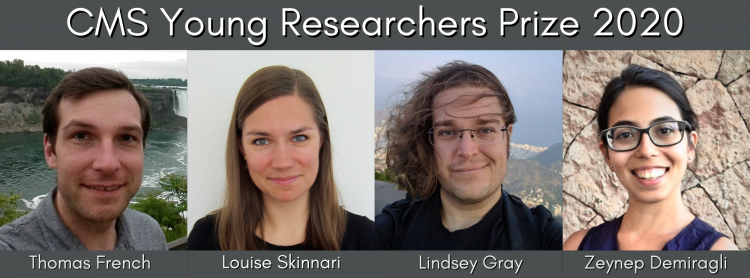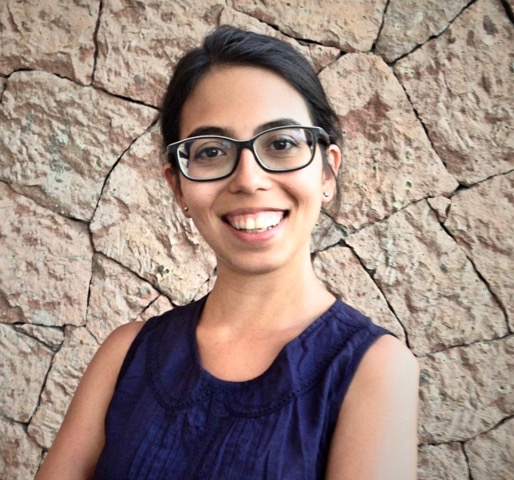
Congratulations to the winners of the CMS Young Researchers Prize 2020! The prize is intended to recognize outstanding achievements of young members of CMS. It is awarded annually to at least three members who have made a very significant and sustained contribution to CMS over many years in any area of the experiment (hardware, software, technical, analysis etc).
The awardees explain what their research was about and how they have impacted the development of new technologies and future research at CMS.
 Zeynep Demiragli: The Standard Model describes the basic building blocks of matter and their interactions with excellent numerical precision. However, evidence suggests that it is incomplete as it does not explain the nature of dark matter and dark energy, and the vast hierarchy between the electroweak and Planck scales. In my research I use the data collected by the CMS experiment to search for evidence of physics beyond the Standard Model to address these open questions. Specifically, I explore signatures with one or more jets and an overall momentum imbalance to discover and characterize the nature of dark matter particles. I also utilize the Higgs boson as a tool for discovery for new physics by searching for its decay to invisible particles.
Zeynep Demiragli: The Standard Model describes the basic building blocks of matter and their interactions with excellent numerical precision. However, evidence suggests that it is incomplete as it does not explain the nature of dark matter and dark energy, and the vast hierarchy between the electroweak and Planck scales. In my research I use the data collected by the CMS experiment to search for evidence of physics beyond the Standard Model to address these open questions. Specifically, I explore signatures with one or more jets and an overall momentum imbalance to discover and characterize the nature of dark matter particles. I also utilize the Higgs boson as a tool for discovery for new physics by searching for its decay to invisible particles.
“Her crucial and sustained contributions to the searches for new physics especially using mono jet signatures, to the JetMet group and to the trigger and data acquisition in CMS.”
 Thomas French: I have been working on a few different aspects of upgrades to CMS over the past four years. With colleagues from CMS and other CERN departments, I helped to develop an electrical “freewheel” system to protect the CMS solenoid by keeping it on when there is a power cut. More recently, I have been working on the new High Granularity Calorimeter (HGCAL), which will be installed in a few years’ time, trying to ensure that the detector and all its services (cables, gas and cooling pipes, and optical fibres) will actually fit when we build and install it in CMS. I have also been carrying out research into the cooling of the Tracker, where two-phase CO2 at -35°C will be pumped through the detector to keep it cool and at a stable temperature. I am developing a small heater that injects bubbles into the flow and will improve cooling performance downstream.
Thomas French: I have been working on a few different aspects of upgrades to CMS over the past four years. With colleagues from CMS and other CERN departments, I helped to develop an electrical “freewheel” system to protect the CMS solenoid by keeping it on when there is a power cut. More recently, I have been working on the new High Granularity Calorimeter (HGCAL), which will be installed in a few years’ time, trying to ensure that the detector and all its services (cables, gas and cooling pipes, and optical fibres) will actually fit when we build and install it in CMS. I have also been carrying out research into the cooling of the Tracker, where two-phase CO2 at -35°C will be pumped through the detector to keep it cool and at a stable temperature. I am developing a small heater that injects bubbles into the flow and will improve cooling performance downstream.
“His crucial and sustained contributions for the environmental control and systems integration of the Endcap Calorimeter upgrade and to the activities of Technical Coordination, especially in reducing risks to the long-term operation of the magnet.”
 Lindsey Gray: My research involves understanding how to take recorded information from complex particle detectors and turn it into physically meaningful objects which then allow us to probe the fundamental structures of nature. I deeply studied two detectors that provide new capabilities that enhance CMS’s ability to do physics. One is the High Granularity Calorimeter (HGCAL) upgrade. It is like an enormous digital camera which takes high resolution pictures of particles interacting within it. This high resolution, when well-used, increases CMS’s sensitivity to signatures of new physics and makes measurements of known fundamental properties more precise. The second detector is called the MIP Timing Detector (MTD) and is also an upgrade to CMS. The MTD’s capability to measure the timing of charged particles with 10s-of-picoseconds accuracy will enhance our ability to point out interesting collisions at the upgraded LHC, and gives us a powerful new tool to search for new physics with long-lived particles
Lindsey Gray: My research involves understanding how to take recorded information from complex particle detectors and turn it into physically meaningful objects which then allow us to probe the fundamental structures of nature. I deeply studied two detectors that provide new capabilities that enhance CMS’s ability to do physics. One is the High Granularity Calorimeter (HGCAL) upgrade. It is like an enormous digital camera which takes high resolution pictures of particles interacting within it. This high resolution, when well-used, increases CMS’s sensitivity to signatures of new physics and makes measurements of known fundamental properties more precise. The second detector is called the MIP Timing Detector (MTD) and is also an upgrade to CMS. The MTD’s capability to measure the timing of charged particles with 10s-of-picoseconds accuracy will enhance our ability to point out interesting collisions at the upgraded LHC, and gives us a powerful new tool to search for new physics with long-lived particles
“His crucial and sustained contributions to the physics justification, the design, and the approval of the mip timing detector (MTD), and to the performance studies of the high granularity endcap calorimeter.”
 Louise Skinnari: My research involves studying the smallest building blocks of matter and the forces through which these tiny particles interact. This work uses the CMS detector at the LHC at CERN, with an ultimate goal to understand better how nature and our Universe works. More specifically, my research is focused on studying the heaviest of all known elementary particles – the top quark, and how it is produced and behaves at the high energies attained in the LHC collisions. One of the many mysteries around the top quark is why it is so heavy in the first place. In addition, much of my work is focused on developing fast identification of electrically charged particles for the upcoming upgrade of the CMS detector. This will improve how CMS decides in real-time which collisions to read out and save. This research seeks to expand our knowledge around fundamental physics questions.
Louise Skinnari: My research involves studying the smallest building blocks of matter and the forces through which these tiny particles interact. This work uses the CMS detector at the LHC at CERN, with an ultimate goal to understand better how nature and our Universe works. More specifically, my research is focused on studying the heaviest of all known elementary particles – the top quark, and how it is produced and behaves at the high energies attained in the LHC collisions. One of the many mysteries around the top quark is why it is so heavy in the first place. In addition, much of my work is focused on developing fast identification of electrically charged particles for the upcoming upgrade of the CMS detector. This will improve how CMS decides in real-time which collisions to read out and save. This research seeks to expand our knowledge around fundamental physics questions.
“Her crucial and sustained contributions to the studies of the top quark, especially the measurement of the production cross-section, and the development of the track reconstruction in the level-1 trigger for the HL-LHC.”

